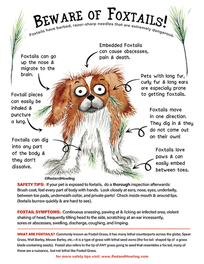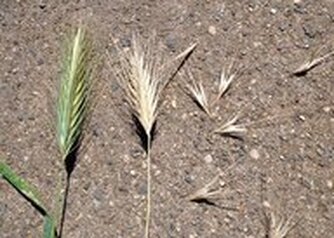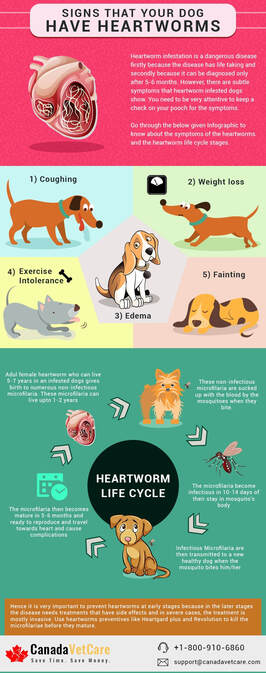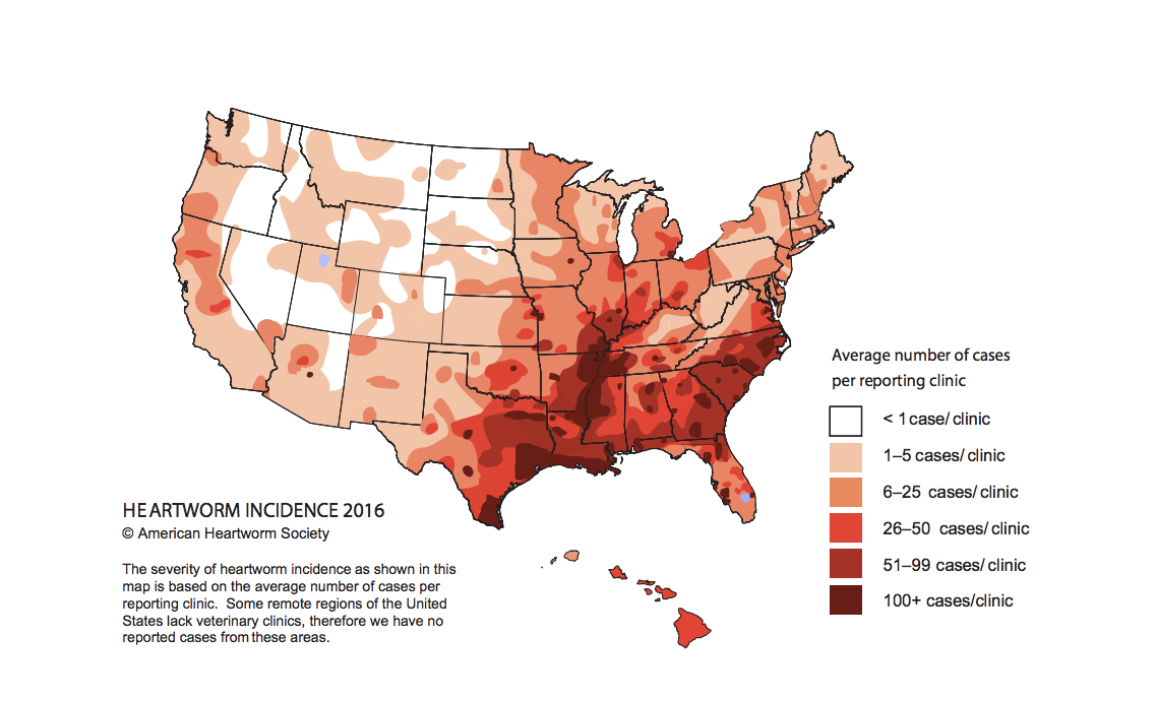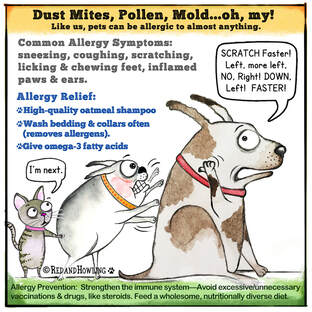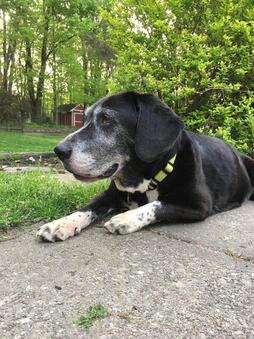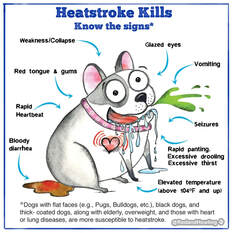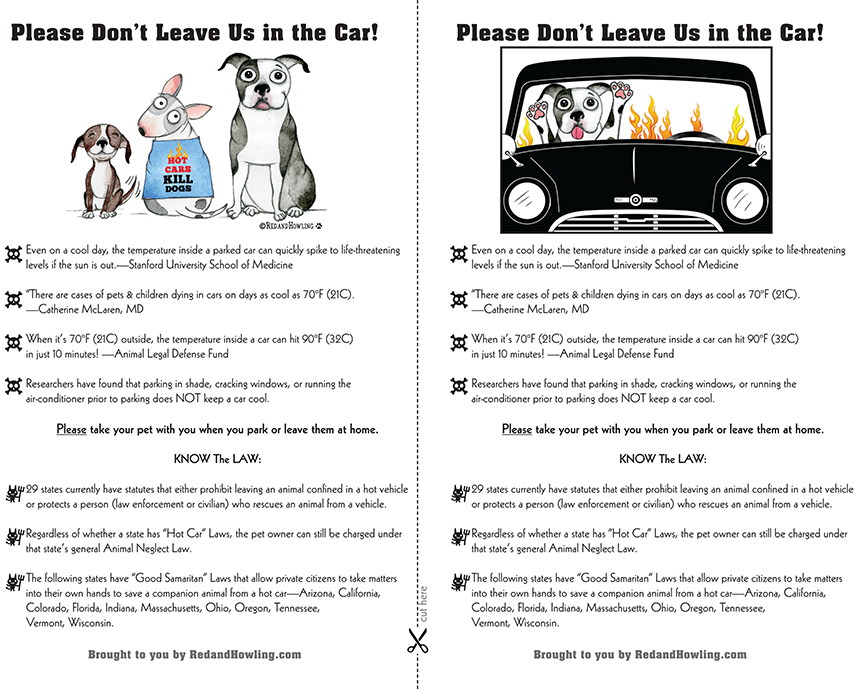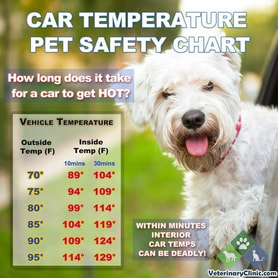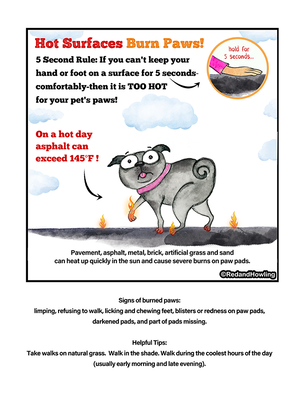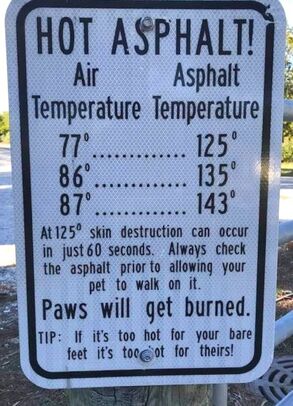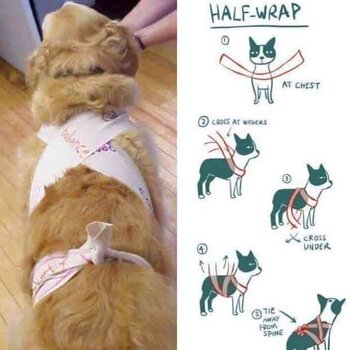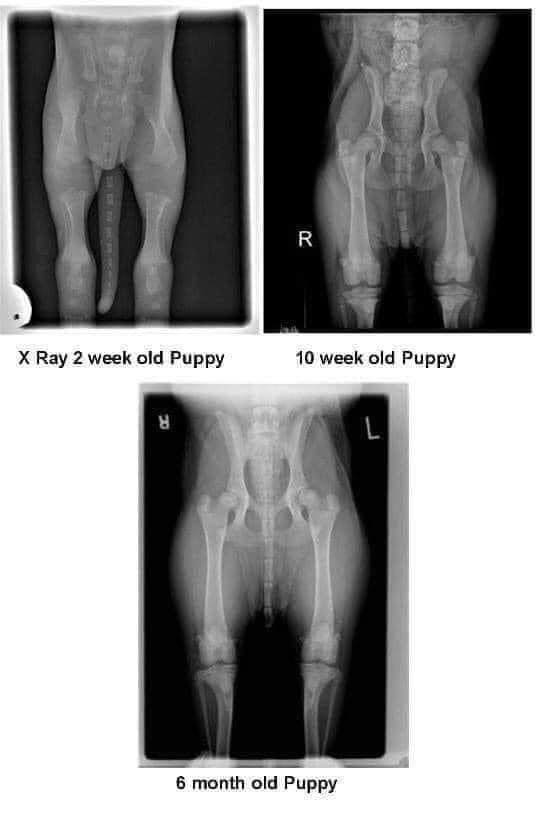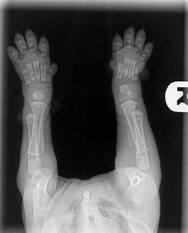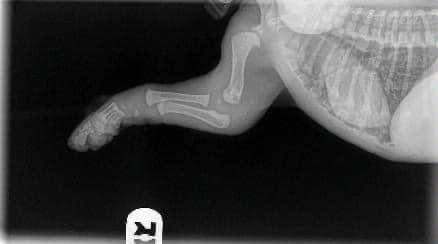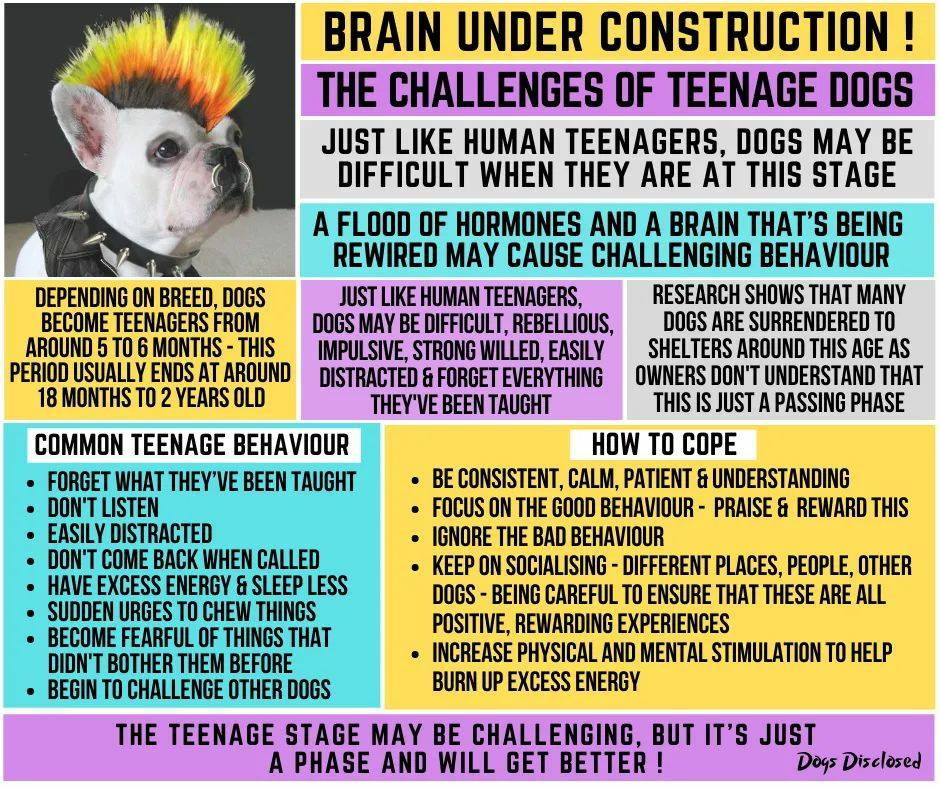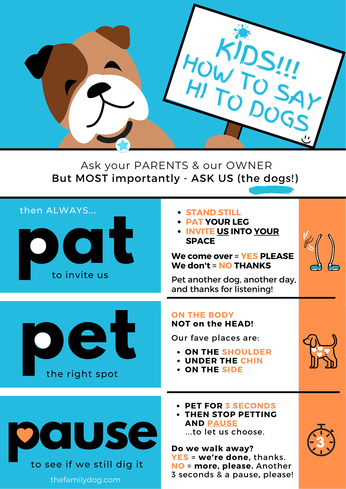PAWS
Information about Your Dog
|
Foxtail Grass: Awns of Destruction
for Western Dogs Foxtail awns present the most insidious threat to the health of dogs in the Western United States. Here is how to identify foxtails, get them off your property, and protect your dog. Foxtails Are Designed to Penetrate Anything!
The seeds of this nasty grass seem to have a special affinity for invading dogs’ bodies. The three most common hazards are these: They get sniffed into dog noses, work their way into dog ears, and lodge between dog toes. Each of these sites is a mere port of entry for these sturdy seeds; once inside, they start a relentless crawl forward, traveling deeper into a dog’s tissue with every passing hour. They are sometimes found in exploratory surgeries years afterward; the durable seed and awn fibers resist breaking down in the body as if they were made of plastic. Those common jumping-off points for the foxtail’s inner-dog journey are not the only ones, however. Foxtails can penetrate any part of your dog; all they need is a place to attach. In dogs with very short hair (like American Pit Bull Terriers, Vizslas, and Weimaraners), they need a fold in the skin of some kind (armpit, vagina, prepuce). To these bristly seeds, longer, thicker, or curly coats behave a little like the “loop” side of a Velcro-type hook-and-loop fastener; a foxtail can stick to the coat, and wherever it sticks, it will start to burrow, enabling the seeds to penetrate anywhere on the furry dogs’ bodies. If your dog has been anywhere near foxtails, and has any sort of abnormal sign of discomfort or irritation – shaking her head, an uncharacteristic squint, repetitively licking her paw or other part of her body, sneezing, coughing, gagging – call your vet and make an appointment as soon as possible. HEARTWORM
WHY HEARTWORM PREVENTIVE?
Click on the Map to Enlarge
Heartworm disease is a serious and potentially fatal disease in dogs in the United States.
Many factors must be considered, even if heartworms do not seem to be a problem in your local area. Your community may have a greater incidence of heartworm disease than you realize—or you may unknowingly travel with your pet to an area where heartworms are more common. Heartworm disease is also spreading to new regions of the country each year. Stray and neglected dogs and certain wildlife such as coyotes, wolves, and foxes can be carriers of heartworms. Mosquitoes blown great distances by the wind and the relocation of infected pets to previously uninfected areas also contribute to the spread of heartworm disease (this happened following Hurricane Katrina when 250,000 pets, many of them infected with heartworms, were “adopted” and shipped throughout the country). The fact is that heartworm disease has been diagnosed in all 50 states, and risk factors are impossible to predict. Multiple variables, from climate variations to the presence of wildlife carriers, cause rates of infections to vary dramatically from year to year—even within communities. And because infected mosquitoes can come inside, both outdoor and indoor pets are at risk. Reprint from The American Heartworm Society SKIN IRRITATIONS AND ALLERGIES
A Simple, Natural Solution for Your Itchy Dog
Allergies are a hypersensitive and damaging response of the immune system to external allergens, such as pollen and food. Medically known as canine atopic dermatitis (CAD), dry, itchy skin can be a major issue for dogs. If left untreated, it can lead to lesions, hair loss, or bacterial infections. It can be caused by a variety of factors, such as a hypersensitivity to allergens. Fortunately, there are many ways to help boost your dog’s immune system and fight the itchy and dry skin. Some studies have shown promise with Omega-3 supplementation in the diet of dogs suffering from allergies. And although simply giving your dog a supplement is unlikely erase the symptoms, (always consult your vet for a complete treatment plan) there is pretty clear evidence that Omega-3 fatty acids provide benefits to the immune system, and many dogs are in fact deficient in Omega fatty acids due to the fact that dog’s cannot produce them on their own. OMEGA 3,6,9 for dogs, made from krill, has some of the highest concentrations of Omega’s of any marine animal. LOST, FOUND STOLEN, IN ACCIDENT, REHOMING
DOGS - Lost, Found, Stolen, in Accident, Rehoming
Tips below grouped in various scenarios in hopes of reuniting dogs with their owners (with extra tips for Abq, NM): LOST PET: Put a lost pet sign up in your front yard in case someone finds it and drives through the neighborhood to locate its home. (A simple sign works best - large clear photo, word “Lost” and phone number on bright paper). Thoroughly check inside your home, especially if this is a new/shy/scared pet. A pet needs to be kept inside minimum 30 days to know where “home” now is (and with all the predators around - people, cars, coyotes, snakes, hawks, etc. it is suggested you keep your pets inside all the time - outside only when you are with them.) Put your shoes and worn clothes outside where the dog went missing from and at home since dogs can smell their humans' scent up to 11 miles away. Spread some of owner’s urine around the yard. Check with neighbors with photos of your dog as sometimes they accidentally get shut in garages or sheds. Put up flyers. Ask your mail carrier if your pet has been spotted. Post to the app Nextdoor and on the various Facebook groups for your area. Walk the neighborhood (vs. drive - your pet may hear you and run to the road but you will already be gone and your pet could get hit). Do you have another dog it is buddies with? Take that dog with you (on a leash/harness!) as you walk around. Keep checking those areas. If you see your dog, do not chase but sit and remove any hat and sunglasses. Your dog needs to see your face. Crazy as it sounds - Do Not Call Your Dog! (check this page out for further clarification - https://www.missinganimalresponse.com/dont-call-dog/) Is there some routine you two follow outside? If so, be sure to follow that routine. Check the lost and found section in local and nearby towns’ newspapers. Lost pets can travel some distance (either on their own, by hitchhiking on a vehicle, or by being rescued and then lost again in a new location) and may be farther away from home than you think. SHELTER (a must go to resource!): Personally check your local shelter(s) every couple days instead of calling. Animals are brought in constantly. Stray animals are available for adoption after a short time. Plus you know your pet best! They often look/act differently in a shelter environment. And some shelters do euthanize as needed for space. Checking local shelters in person every couple days is a vital step! MICROCHIP: If your pet is microchipped, please make sure your contact info is always up to date. You can and need to update it, especially when your pet is missing!!! And still check shelters in person as microchips can sometimes fall out or travel to other parts of the animal’s body. FACEBOOK: Social media is highly successful! Share to the following Facebook pages and apps: - Nextdoor (especially great as covers your own neighborhoods!) - Pawboost - https://www.pawboost.com/ - Use search feature on Facebook…lost/found dogs and cats plus location (there may be several for your area - neighborhood, town, county, State) - FB page “New Mexico - lost dogs, cats & pets” - Check Animal Humane of NM as well - Check your shelter’s FB page and websites for animals currently in there (note: this is in addition to checking in person minimum every other day!) - Craigs List for any posts about your pet being found. You might also consider posting an ad yourself that your pet is missing. (For Abq: https://albuquerque.craigslist.org/) - Pet Harbor - www.petharbor.com - Petfbi.org for nationwide search plus link to more valuable tips - Finding Rover (www.findingrover.com) - uses facial recognition to search (130 scan points such as fur color, texture, snout length, space between the eye). 98% success rate but is dependent on shelters, rescues, etc. partnering with them. Upload photo of your lost pet on the app, add some basic info, click “lost” or “found” and it will scan database for possible matches, either locally or anywhere in the country. Company is partnered with 600+ shelters around the U.S. and adding more every week- added layer of protection. Does not replace getting your pet microchipped. Note: When send your pet’s information to any of these pages put name of pet, detailed description, date missing, area missing from (including name of town and cross streets), pictures of your pet, and your contact information. You might want to include if pet is spayed/neutered, microchipped, and any other tips that may help someone catch it should they come across it (personality traits and things pet likes). STOLEN: Check https://petfbi.org/how-to-protect-your-pet/stolen-pets/ for tips. Includes filing a police report, contacting your local media (TV stations, newspapers) and checking Craig’s List where your pet may be posted for sale. Check any nearby security camera footage. IN AN ACCIDENT/STRANGE AREA: Stay in the area if possible!!! Also others pet knows. Pets rarely stray far and may hide for 1-2 days first. Leave scent items (your clothing, pet’s bed/toys/poop, etc) and smelly food and water. Many return to that spot late night or early morning when activity is minimal. Flyers with “do not chase” (your pet is in flight/scared/survival mode) and searching every day is vital. Sit and talk softly when seen. Post on Lost Pets of Auto Accidents Facebook page. Additional tips: - https://www.missinganimalresponse.com/lost-dog-behavior/ - www. missingpetpartnership.com - https://www.helpinglostpets.com - Calming a panicked dog: https://youtu.be/cmiZzB643is Hope your pet finds its way home safe and soon!!! FOUND PET: If this is a found pet, please have it scanned for a microchip at any vet or shelter. Free service. In Albuquerque Petroglyph Animal Hospital is open 7 days a week tho not 24 hours. Both Route 66 Veterinary Emergency & Critical Care Center and VCA Montgomery are open 24 hours. If there is a rabies tag, the vet who issued it should be able to help. Post on Nextdoor, Pawboost and other social media. Call 311 if in Abq. Put up fliers in your neighborhood. Also, please please ask for proof of ownership!!! There are people who love free animals to sell, use as bait for dog fighting rings, etc. (Yes they do exist as much as we wish they didn’t). When posting a found animal, do NOT include details only the true owner would know such as the color of the animal’s collar. Some tips under “lost dog” above apply to found dog as well. REHOMING AN ANIMAL: Please be very careful about rehoming. There are bad people out there who will try to fool you. A lot of them women as they seem less threatening. They love free animals for breeding, ransom or for sadistic purposes such as bait in dog fighting rings (yes, they do sadly exist), food for snakes, target practice, etc. Verify placement and do a home visit if possible. At the very least ask for a small rehoming fee. Ask a rescue to help as they are experienced. Take to the Shelter (if option is available) where it will receive shelter, food, and water. Good luck! Truly hope something above helps! GRAPE AND RAISIN TOXICITY IN DOGS
Dogs are exposed to grapes and raisins in many ways. Frequently, dogs will eat fruit off the vine, steal from plates, and even eat wine pressings. Grapes and raisins have been recom- mended as treats and training aids because fruit is tasty and relatively low in calories. Unfortunately, dogs can have dangerous reactions to grapes and raisins. Between January 2001 and August 2004, over 200 calls were made to the ASPCA Animal Poison Control Center1 involving potential exposures to grapes or raisins in dogs. Sensitive dogs have a risk of initial gastrointestinal upset followed by acute renal failure (ARF). This column discusses clinical signs and treatment of grape and raisin toxicosis in dogs.
10 Pet Sanctuaries Where You Can Adopt a Senior Dog
At animal shelters and rescue facilities across the country, senior pets are often the last to be adopted. Even though older dogs and cats are usually housetrained, well socialized and don’t require the same amount of supervision as puppies and kittens, they are sadly overlooked in the adoption process.
PAGE LINK |
Heatstroke Kills
Even when you think the temperature is OK or feels fine to you, your fur kid may feel very differently
HOT CARS KILL
Dogs in hot cars can suffer from potentially fatal heat stroke in as little as 15 minutes. Dogs die in hot cars as they can overheat very quickly and struggle to cool themselves down, even when a window has been left open or water has been left in the car.
Hot Surfaces Burn Paws!
Hot sidewalks, asphalt and other surfaces can hurt a dog’s paws.
Dogs showing these symptoms may have burned paws: Limping or avoiding walking Licking or chewing feet Paw pads are darker in color than usual Pads are visibly damaged Blisters or redness First aid for burned paws If you suspect your dog has burned paw pads: Bring your dog inside right away. Carry your pet if necessary. Flush the foot with cold water or use a cold compress. Try not to let your dog lick the injured pad. Take your dog to the vet as soon as you possible because burns can become infected. Your dog might need antibiotics or pain medication depending on the severity of the burn. The vet can also rule out other possible causes of the symptoms. Paw licking can also be a sign of other problems, such as allergies. How do I protect my pet’s paws from the heat? Dog booties and socks help shield against the hot pavement. Try to avoid walking on streets or sidewalks in the middle of the day, when it’s hottest. If your pooch seems uncomfortable on a manmade surface, head for grass, which stays cooler than pavement. Do take your dog for walks on pavement when the weather is cooler. This will help your dog’s paws form calluses, which will make the skin thicker and less prone to burns and other injuries. SCARS wishes to thank Amy Luwis, Cartoonist •
Animal Cruelty Avenger -for her posters... RedandHowling.com Co-Founder • Adopt-a-Pet.com Please Adopt, Don't Shop IF YOUR DOG IS OVER REACTIVE TO THUNDERSTORMS, FIREWORKS OR OTHER
LOUD NOISES Here is a very simple way to keep your dog from having a nervous breakdown during thunderstorm or firework displays!
This even helps dogs who are nervous when riding in the car or going to a vets office. It’s a very calming technique that helps them to stay relaxed and feel safe. All you need to apply this technique is a simple scarf or piece of fabric. You start wrapping at the chest, cross in the back at the withers, bring the ends underneath the chest, crossing them and back up & tie into place (just to the side of the spine). You don’t want to put any pressure on the spine. This is essentially a hug and is the next best thing to having your arms around your pet. if you don’t feel like making one, you can actually buy them online, they’re called thunder wraps. Facebook: Doggie Stuff - Wagging Tails Project
THIS IS A MUST READ ABOUT YOUR PUPPIES DEVELOPMENT!
This is something everyone should see.When you get your 8/10 week old puppies, please keep this image in mind. A lot of their bones do not even touch yet. They plod around so cutely with big floppy paws and wobbly movement because their joints are entirely made up of muscle, tendons, ligaments with skin covering. Nothing is fitting tightly together or has a true socket yet.
When you run them excessively or don't restrict their exercise to stop them from overdoing it during this period you don't give them a chance to grow properly. Every big jump or excited bouncing run causes impacts between the bones. In reasonable amounts this is not problematic and is the normal wear and tear that every animal will engage in. But when you're letting puppy jump up and down off the lounge or bed, take them for long walks/hikes, you are damaging that forming joint. When you let the puppy scramble on tile with no traction you are damaging the joint. You only get the chance to grow them once. A well built body is something that comes from excellent breeding and a great upbringing-BOTH, not just one. Once grown you will have the rest of their life to spend playing and engaging in higher impact exercise. So keep it calm while they're still little baby puppies and give the gift that can only be given once. Your dogs growth plates are done maturing at 2 years of age. Juvenile spaying and neutering interrupts proper brain & bone development, YOUR TEENAGE DOG
Somewhere around 5 to 6 Months - Be Patient! Keep the Dog Inside the Fence!
By Teoti Anderson
I was training a client and her dog outside in her neighborhood when a scruffy dog happily approached us. There was no owner in sight. I slipped a spare leash on him and checked his collar. Luckily, “Fred” had an ID tag. I called the number. “Hello,” I said when a woman answered. “I found a loose dog in the Vista area. I believe he’s yours; his name is Fred.” “That can’t be my dog,” the woman snapped. “Fred is right here next to me. Fred? FRED?!” The woman sheepishly arrived five minutes later to collect Fred, who was, indeed, hers. She had been sunbathing outside when Fred hopped the fence and went on a walkabout. Fence jumpers are a pet parent’s nightmare. It’s frustrating when you have an escape artist, and it’s also dangerous. What if he doesn’t find his way home? What if he gets hurt or hit by a car? What if someone takes him and you never see him again? Once a dog starts escaping a yard, it can become a habit. This is because when your dog leaves, there’s potential for a grand and rewarding adventure. He explores smells, gets into trash, chases critters, and gets attention from other people. Why should he stick around his boring backyard when the world awaits? Containing Your Escape Artist Keeping your Houdini hound in his yard can be tricky, depending on how he’s getting out. If it’s because someone left the gate ajar, that’s one thing. If he’s digging under or jumping over, that’s an additional challenge. Carefully search your perimeter and make sure there are no gaps in the fence, no holes on the ground, and no objects near the fence your dog can jump on to propel himself over. Some dogs are climbers – does your fencing offer pawholds? If your dog is digging under, one option is to bury chicken wire from the bottom of the fence inwards several feet. When your dog digs, he’ll just reach wire and won’t be able to form an escape tunnel. More importantly, create an environment your dog doesn’t want to leave. Some pet parents get hurt when their dog seems to prefer escaping to hanging out at home. Just because he escapes doesn’t mean he doesn’t love you. He’s enjoying a rewarding experience somewhere else. Your job is to create a backyard that is too enticing for him to want to leave. Ensure he has five to six chew toys that he enjoys. Rotate them every day for a different batch. Playing with the same toys day in and out is boring. Hide frozen food-stuffed rubber toys in the yard for him to seek and enjoy. Train your dog in your backyard, especially working on coming when called. Teach him to wait at the gate until you cue him to exit. Play games with him there so he associates the area with fun, rather than a place where he is left alone all the time. Ensure he is getting enough cardio exercise each day for his age and breed(s). Running around a yard is not enough exercise for many dogs. Consult your veterinarian if you have questions about how much exercise your dog needs. Ideally, you can supervise your dog while he’s outside, even if it’s just checking on him through a window. Leaving a dog unattended outdoors can be risky, especially in areas where dog theft is an issue. Very small dogs should never be left unattended outdoors when large predatory birds are known to live in the area. A small dog is the same size as a rabbit, and a hawk can easily snatch one up as a snack. Also, please ensure your dog is always wearing identification. If your dog has a microchip, please ensure the information associated with the chip is up to date. Fred’s ID tag helped me get him home quickly. His mom ended up so relieved she offered me a glass of wine as a reward! (I was working, so I declined. But still nice!) This article was reviewed/edited by board-certified veterinary behaviorist Dr. Kenneth Martin and/or veterinary technician specialist in behavior Debbie Martin, LVT. Teoti Anderson, CPDT-KA, KPA-CTP, is the vice president of A Dog’s Best Friend, located in Ft. Lauderdale, Florida. Fear Free Happy Homes FOR KIDS AND ADULTS - SAYING HI TO A DOG
|
